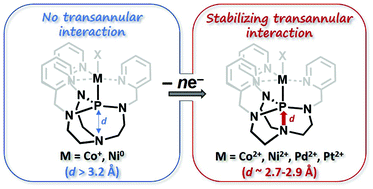Adaptable ligand donor strength: tracking transannular bond interactions in tris(2-pyridylmethyl)-azaphosphatrane (TPAP)†
Abstract
Flexible ligands that can adapt their donor strength have enabled unique reactivity in a wide range of inorganic complexes. Most examples are composed of flexible multi-dentate ligands containing a donor that can vary its interaction through its distance to the metal center. We describe an alternative type of adaptable ligand interaction in the neutral multi-dentate ligand tris(2-pyridylmethyl)-azaphosphatrane (TPAP), which contains a proazaphosphatrane unit. Prozaphosphatranes are intrinsically strong phosphorus donors; upon coordination to more Lewis acidic atoms the phosphorus can accept additional electron density from a tertiary nitrogen to form a transannular bond, increasing its donor strength. An experimental and computational investigation of the varying degree of transannular interaction in TPAP when coordinated to late transition metals is reported. The synthesis and characterization of the complexes M(TPAP), where M = Co(I)Cl, Ni(0)(1,5-cyclooctadiene), Ni(II)(CH3CN)(BF4)2, Pd(II)(CH3CN)(BF4)2, or Pt(II)Cl(PF6) is described. Structural characterization and density functional theory calculation of these complexes, along with the previously reported [Co(II)(TPAP)(CH3CN)](BF4)2 establish significant increases in the degree of transannular interaction of the proazaphosphatrane unit when coordinated to more electron deficient metal ions.



 Please wait while we load your content...
Please wait while we load your content...
